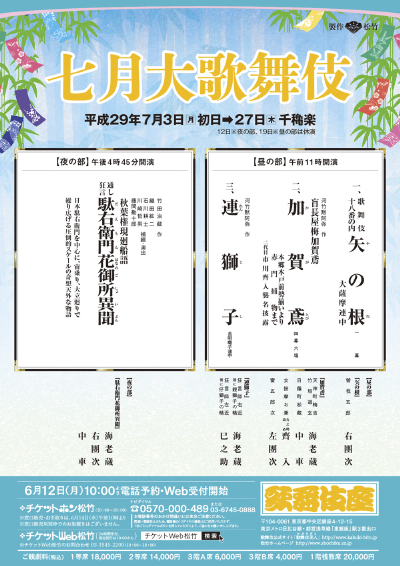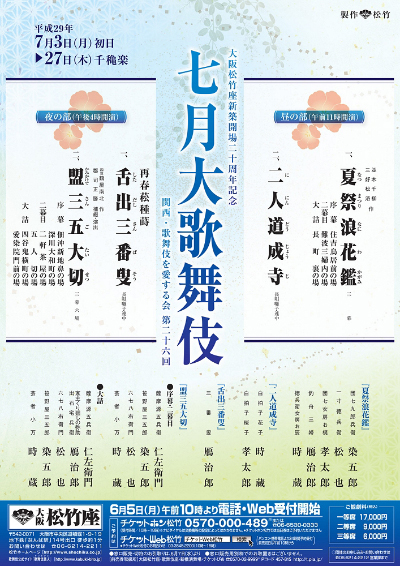| JULY 2017 |
|
3 shows in T˘ky˘ (Kabukiza, National Theatre), 2 in ďsaka (Sh˘chikuza), 1 in Hita (Patria Hita) and 2 tours (Eastern Provinces, Central Provinces)!
|
| Kabukiza (T˘ky˘) |  |
| Dates | 3 ~ 27 July 2017 (Shichigatsu Hanagata Kabuki) July Young Actors Kabuki |
| MatinÚe | |
| Evening |
Daemon Hana no Gosho Ibun |
| Casting |
Ichikawa Ebiz˘, Ichikawa Sadanji, Ichikawa Udanji, Ichikawa Chűsha, Band˘ Minosuke, Ichikawa Sai'nyű, Ichikawa Danz˘, Kataoka Ichiz˘, Ichimura Kakitsu, Kawarasaki Gonjűr˘, Band˘ Shűch˘, Nakamura Kikaku, Ichikawa Omez˘, Ichikawa Kudanji, Ichikawa Emisabur˘, Ichikawa Emiya, Band˘ Shingo, Nakamura Kotar˘, ďtani Hiromatsu, Ichikawa K˘tar˘, Ichikawa Otora, Horikoshi Kangen |
| Comments |
The zagashira of these July Grand Kabuki programs is Ichikawa Ebiz˘. Ichikawa Unosuke III takes the name of Ichikawa Sai'nyű II, playing the role of Okane in the drama "Kagatobi". This name has not been held for more than one century. Ichikawa Sai'nyű I was the great-grandfather of Ichikawa Unosuke and he held this name in his latter years, from January 1909 to his passing away the 18th of March 1916. Takeda Haruz˘'s drama "Akiba Gongen Kaisen Banashi" is revived in the evening program with Takeda Haruz˘'s drama "Akiba Gongen Kaisen Banashi" is revived in the evening program, with a different title, "Daemon Hana no Gosho Ibun", as the main character in this revival is Nippon Daemon (played by Ichikawa Ebiz˘). "Akiba Gongen Kaisen Banashi" was staged only twice since the beginning of the Sh˘wa era: in October 1934 at the Shinbashi Enbuj˘ and in May 2011 at the National Theatre. It was in both times a Zenshinza production. The role of Nippon Daemon was played by Kawarasaki Ch˘jűr˘ IV in 1934 and by Arashi Keishi in 2011.
|
 |
| Sh˘chikuza (ďsaka) |  |
| Dates | 3 ~ 27 July 2017 (Kansai Kabuki o Ai Suru Kai Shichigatsu ďkabuki) The 26th Kansai Kabuki Lovers Society July Grand Kabuki |
| MatinÚe |
|
| Evening | |
| Casting |
Living National Treasure Kataoka Nizaemon, Nakamura Tokiz˘, Nakamura Ganjir˘, Ichikawa Somegor˘, Kataoka Takatar˘, Onoe Matsuya, Band˘ Takesabur˘, Matsumoto Kingo, Kamimura Kichiya, Nakamura Kazutar˘, Arashi Kitsusabur˘, Kataoka Matsunosuke, Nakamura Jűjir˘, ďtani Hirotar˘, Nakamura Mantar˘ |
| Comments |
26th edition of the Kansai Kabuki Lovers Society July Grand Kabuki in ďsaka.
|
 |
| National Theatre (T˘ky˘) |
| Dates | 3 ~ 24 July 2017 (Shichigatsu Kabuki Kansh˘ Ky˘shitsu) July Kabuki Appreciation Class |
| Program |
Kabuki no Mikata
|
| Casting |
Onoe Kikunosuke, Band˘ Hikosabur˘, Nakamura Baishi, Onoe Ukon |
| Comments |
Educational program at the National Theatre called Kabuki Kansh˘ Ky˘shitu ("Kabuki Appreciation Class"). This is a very interesting formula for the beginners because there is lively presentation of Kabuki (or some aspects of the art like music, stage tricks or fighting scenes) on stage, followed by a drama ("Ichij˘ ďkura Monogatari").
|
| Kabuki Tour in the central provinces | |
| Dates | 30 June ~ 30 July 2017 (Sh˘chiku ďkabuki) Sh˘chiku Grand Kabuki |
| Program | |
| Casting |
Living National Treasure Nakamura Kichiemon, Nakamura Jakuemon, ďtani Tomoemon, Nakamura Matagor˘, Nakamura Kash˘, Nakamura Yonekichi, Nakamura Tanenosuke, Nakamura Kichinoj˘ |
| Comments |
The usual July Grand Kabuki Tour in the central provinces. Nakamura Jakuemon V celebrates his shűmei.
|
| Kabuki Tour in the Eastern Provinces | |
| Dates | 30 June ~ 31 July 2017 (Sh˘chiku ďkabuki) Sh˘chiku Grand Kabuki |
| Program | |
| Casting |
Nakamura Shikan, Nakamura Baigyoku, Nakamura Senjaku, Nakamura Karoku, Ichikawa Komaz˘, Nakamura Hashinosuke, Nakamura Fukunosuke, Nakamura Baika |
| Comments |
The usual July Grand Kabuki Tour in the Eastern Provinces. Nakamura Shikan VIII and two of his three sons, Nakamura Hashinosuke IV and Nakamura Fukunosuke III, celebrate their shűmei.
|
| Patria Hita (Hita) | |
| Dates | 1 ~ 2 July 2017 (Band˘ Tamasabur˘ Tokubetsu Buy˘ K˘en) Band˘ Tamasabur˘ Special Dance Performances |
| Program |
Keisei |
| Casting |
Living National Treasure Band˘ Tamasabur˘ |
| Comments |
A special Buy˘ program starring the amazing Living National Treasure onnagata Band˘ Tamasabur˘ in Hita in ďita Prefecture at the Patria Hita which celebrates the 10th anniversary of its opening.
|
|
|
| Contact | Main | Top | Updates | Actors | Plays | Playwrights | Programs | Links | FAQ | Glossary | Chronology | Illustrations | Prints | Characters | Derivatives | Theaters | Coming soon | News |